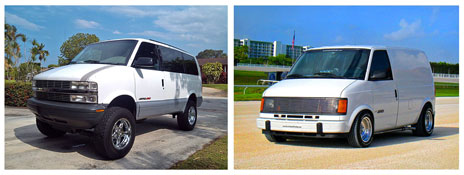

The odometer reads just 103K miles and the truck has spent its entire life in Tennessee, so despite the sun-scorched clearcoat, the metal is remarkably solid. The interior is decent but the floor is pretty stained. It feels [mostly] mechanically sound but it does have a few issues.
I have grand plans of eventually replacing the factory 4.3L/4L60E combo with either an LQ4/9 6.0L or 6.5L TD backed by an NV4500 and a true hi/low transfer case. BUT, for the time being, I just need to confirm the van is reliable as-is. My family is spending the next six months in my Michigan hometown and this van not only has to take us there (about a 700-mile drive), but it will also become my winter ride once we've arrived. What are the typical trouble areas with these vans? What should I check/adjust/change/etc first?
I'm not very familiar with the Astro/Safari AWD system. I believe my 95 uses an oil-driven transfer case that engages the front differential when heat/friction create a certain viscosity in the fluid, unlike the later models that use Auto-Trak style servos. I've read cases where a simple change of old TC fluid made immediate improvements in AWD performance. Are there any simple methods for diagnosing the condition/performance of these transfer cases?
Do the front and rear differentials use the same type of oil?
The transmission is supposedly a recently-installed, remanufactured unit and it shifts smoothly. The engine makes good power, keeps its cool, and I see no evidence of coolant in the oil. It does occasionally shudder at idle speeds and especially upon start-up. I do not have an OBD1 scanner, unfortunately.
I will occasionally hear/feel a "clunk" when pulling off the line or coming to a stop which I assume is coming from the driveline. Is this common?
Lastly, the steering doesn't feel quite right. The power assist feels like it cuts in/out through the same turn, which would normally indicate pump failure or a leak in the system, but fluid level never changes and there are no visible leaks. I've read that the AWD steering feel is different and just something you have to get used to, so I don't know if this is normal or not. The wheel does not right itself after completing a turn.
Any and all suggestions appreciated!


